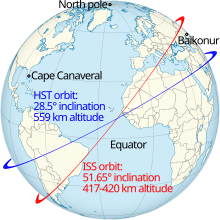 Endeavour on standby at LC-39B, ready to rescue the crew of STS-125 if needed | |
| Mission type | Crew rescue |
|---|---|
| Mission duration | 7 days |
| Spacecraft properties | |
| Spacecraft | Space Shuttle Endeavour |
| Crew | |
| Crew size | 4 up 11 down |
| Members | Christopher Ferguson Eric A. Boe Robert S. Kimbrough Stephen G. Bowen |
| Landing | Scott D. Altman Gregory C. Johnson Michael T. Good Megan McArthur John M. Grunsfeld Michael J. Massimino Andrew J. Feustel |
| Orbital parameters | |
| Reference system | Geocentric |
| Regime | Low Earth |
| Inclination | 28.5 degrees |
 "Unofficial" Mission Emblem | |

STS-400 was the Space Shuttle contingency support (Launch On Need) flight that would have been launched using Space Shuttle Endeavour if a major problem occurred on Space Shuttle Atlantis during STS-125, the final Hubble Space Telescope servicing mission (HST SM-4).[1][2][3][4]
Due to the much lower orbital inclination of the HST compared to the ISS, the shuttle crew would have been unable to use the International Space Station as a "safe haven", and NASA would not have been able to follow the usual plan of recovering the crew with another shuttle at a later date.[3] Instead, NASA developed a plan to conduct a shuttle-to-shuttle rescue mission, similar to proposed rescue missions for pre-ISS flights.[3][5][6] The rescue mission would have been launched only three days after call-up and as early as seven days after the launch of STS-125, since the crew of Atlantis would only have about three weeks of consumables after launch.[2]
The mission was first rolled out in September 2008 to Launch Complex 39B two weeks after the STS-125 shuttle was rolled out to Launch Complex 39A, creating a rare scenario in which two shuttles were on launch pads at the same time.[3] In October 2008, however, STS-125 was delayed and rolled back to the VAB.
Initially, STS-125 was retargeted for no earlier than February 2009. This changed the STS-400 vehicle from Endeavour to Discovery. The mission was redesignated STS-401 due to the swap from Endeavour to Discovery. STS-125 was then delayed further, allowing Discovery mission STS-119 to fly beforehand. This resulted in the rescue mission reverting to Endeavour, and the STS-400 designation being reinstated.[4] In January, 2009, it was announced that NASA was evaluating conducting both launches from Complex 39A in order to avoid further delays to Ares I-X, which, at the time, was scheduled for launch from LC-39B in the September 2009 timeframe.[4] It was planned that after the STS-125 mission in October 2008, Launch Complex 39B would undergo the conversion for use in Project Constellation for the Ares I-X rocket.[4] Several of the members on the NASA mission management team said at the time (2009) that single-pad operations were possible, but the decision was made to use both pads.[2][3]
- ^ NASA Mission Operations Directorate (2 June 2008). "STS-400 Flight Plan" (PDF). NASA. Archived from the original (PDF) on 14 January 2010. Retrieved 19 May 2009.
- ^ a b c Hitt, David (5 May 2009). "STS-400: Ready and Waiting". NASA. Archived from the original on 29 October 2009. Retrieved 17 May 2009.
- ^ a b c d e Atkinson, Nancy (17 April 2009). "The STS-400 Shuttle Rescue Mission Scenario". Universe Today. Retrieved 18 May 2009.
- ^ a b c d Bergin, Chris (19 January 2009). "STS-125/400 Single Pad option progress – aim to protect Ares I-X". NASASpaceflight.com. Retrieved 19 January 2009.
- ^ Bergin, Chris (9 May 2006). "Hubble Servicing Mission moves up". NASASpaceflight.com. Retrieved 16 October 2007.
- ^ Copella, John (31 July 2007). "NASA Evaluates Rescue Options for Hubble Mission". NASASpaceflight.com. Retrieved 16 October 2007.